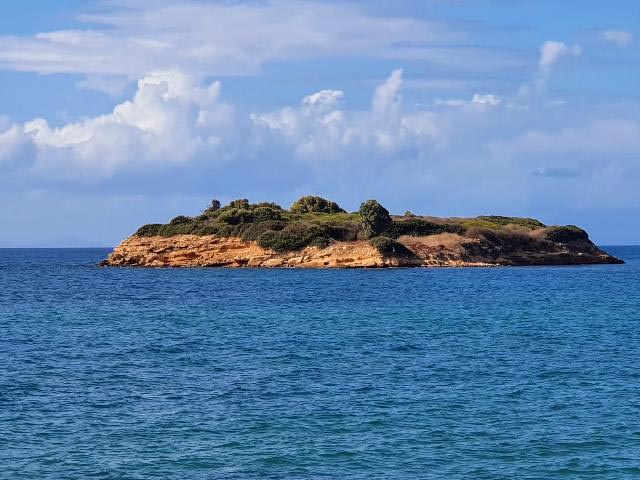News of a possible Minoan harbour located just below the sea-level off Tavşan Adası (Rabbit Island) has created a rush of interest both locally and from my colleagues across Europe, write Glenn Maffia.
It has long been known of a Minoan connection with Miletus region because of the datable pottery found in the vicinity of the city. Also, the etymology of the name ‘Miletus’ is, of course, a Hellenic name in the Ionic dialect. In the Doric dialect it is spelt slightly differently, Milatos. This is believed to refer to an ancient city of the same name on the island we know today as Crete.
Crete was home to the Minoan people named after the legendary King Minos. Hittite documents, an Anatolian people contemporary with the Minoans, refer to the city as Millavanda.
Perspective please
I have noticed that in the clamour for information people have been solely dependent upon the Turkish newspaper articles releasing the story, and news has been dominated by the local ‘intelligentsia’.
What has disturbed me foremost is that the mention of tourism has already been made before any proven evidence has been examined. I realise it has been a sullen season, but let us not go fabricating flights of fancy upon ancient archaeology.

The man to concentrate on here is Francois Bertemes, who has been leading a research team on the island since 2005/6 on behalf of the German Archaeological Institute. The findings of this long-established research have cast doubt onto the validity of the recent sensational news.
A land bridge once connected today’s island with the mainland up until the 6th century CE when a Tectonic subsidence of the coast, by some two metres, disconnected what is now Tavşan Adası from the mainland.
We are speaking about the period we refer to as Byzantine (303-1453 CE). At this point it is worth noting that the entire Milesian Peninsula consists of a rock called Karst. This rock fractures in unusually straight edges.

A short trip to the Latmos Mountain (Turkish: Beşparmak) framing one side of Bafa Lake will confirm this feature. But this is not to state that the alleged ‘harbour’ was formed then, far from it. We must seek more evidence.
Copper or Early Bronze Age evidence
Excavations from 2006-2011 revealed pottery shards which were burned in a reducing method and displaying a red coating relate to a style prevalent during the 3rd millennium BCE, the late Copper or early Bronze Age, and indicate settlement of this then small peninsula.
There are also relics from the 2nd millennium BCE (which corresponds to the Minoan period). Most exceptionally the remains of a craftsman’s quarter which featured the design common during the ‘Old Palace Period’ of Crete, in which houses were arranged around a paved courtyard, this style dates from between 2000-1700 BCE, it is here that the evidence of a Minoan settlement is found in abundance.
A whole plethora of Minoan goods were revealed; pottery, loom weights, spindle whorls and a stone mould for the production of a double axe (labrys), an iconic emblem of the Minoans.
Further items were found dating from the ‘New Palace Period’ that were even more impressive and imply that this settlement was an important trading centre. Though in this seismic volatile region of the world things could change in the blink of an eye, and they did. The massive volcanic eruption on Thera (today Santorini) in approximately 1613 BCE and the accompanying tsunami nigh on obliterated the Minoan way of life.
Let’s Jump!
Therefore, I can understand the conclusions, jumped at by the assembled local dignitaries, about there being a port off today’s island. Certainly the shipwrecks found close by further attest to a mooring point somewhere.
We know the sandy bays to the north and south of the island were possibly used by ships to shelter from Aegean storms, but wild conclusions are not evidence, though they may be seductive.

Francois Bertemes, of course, has also postulated the possibility of there being a harbour which was published by the German Archaeological Institute in September 2011, entitled ‘Tavşan Adası – a Minoan port settlement north of Didyma’. It is not, therefore, exactly breaking news. He did not arrive at any solid evidence.
I have also been reliably informed that Francois Bertemes is also a keen diver and embarked on an underwater investigation along with a number of geologists. For he and his team not to find something tangible and for Mustafa Şentürk, the President of the Didim Cultural Heritage Conservation Association and President of the Didim Tourism Association who appears to be claiming this find, to do so, I feel, is stretching credulity.
In fairness to Mr Şentürk, I also have been confronted by this veil of secrecy which the German Archaeological Institute draws around itself. I have drawn attention to the lack of information being disseminated into the public sphere to the Director’s superiors; they never had the courtesy to reply to my emails. Though I am surprised that Baran Aydın, Miletus Museum Director, was not informed of this, and other finds, at an earlier date.
Nonetheless, I get the distinct impression that this public announcement has more to do with promoting tourism than furthering our knowledge of the ancient past.
While whatever criteria they maintain at least the announcement promotes opening up a historic site to the public. This is entirely praiseworthy. So, why not open the paved section of the Sacred Road to the public?
